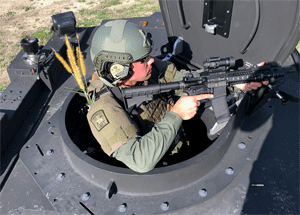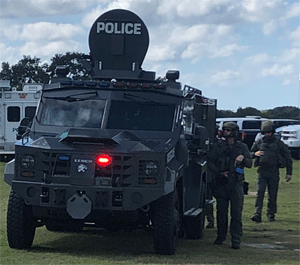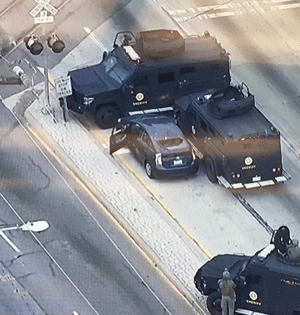
ARMORED VEHICLE TRAINING
The types of armored vehicles that SWAT teams use will vary. There are many companies out there that make armored vehicles including; Lenco Armored Vehicles, Terradyne Armored Vehicles, BATT X, and The Rook. They come in all shapes and sizes, but ultimately armored vehicle operations are for the purposes of providing some ballistic safety and some ballistic coverage for tactical teams to approach target residences or vehicles to affect rescues.
A lot of people go back and reflect on the North Hollywood shootout in Southern California in 1997 where some very smart LAPD officers that had prior military training made the tactical decision to commandeer Brink’s armored trucks and use those trucks to rescue citizens from the parking lot of the bank that was being robbed. It just morphed itself into a tool that most SWAT teams needed. The configuration of armored vehicles can vary, but most of them are basically built on the chassis of a large SUV pickup truck chassis, and they’re armored to be able to withstand certain ballistic and weapon calibers. They’re configured to where you have platforms on the outside that SWAT teams can ride on.
There are turrets on the roof where you can position SWAT officers with any kind of a shoulder weapon or a long rifle. There are gun ports on the inside where you can position officers and they have all kinds of different capabilities, including insert tear gas. You can insert a camera off of a boom that comes off the front. Armored vehicle are very multi-use. Armored vehicle sent the whole discipline of SWAT work into another direction when armored vehicles became very popular amongst a lot of teams in the country and around the world.
Biggest Challenge of SWAT Team Training

The training portion using an armored vehicle is quite frankly “they don’t know what they don’t know.” The armored vehicle training put on by Integrated Tactical Concepts (ITC) includes what works and discussing what doesn’t work with these vehicles. Integrated Tactical Concepts will train SWAT teams using whatever equipment the SWAT team may have.
ITC has had teams in certain training scenarios that show up in up with an armored Chevy 2500 dually because that’s all they have as far as funding. We will work with these folks, and we will come up with a way that they can use that truck for whatever they have and to better suit themselves, but the bottom line for a lot of them is that they obtain these trucks through a mutual agreement with another department. It could be that one department let’s say department “A” over here purchases the truck on a grant, but that grant was gifted because they have to share that truck with department “B, C, and D.” Now we go all the way back to the continuity of the training.
Everybody that is going to be around the truck that is going to be used has to be trained on that truck. People have smashed their hands from the doors on armored vehicles ending up with career ending injuries. People have injured their legs and faces. If agencies do not have a legitimate training program for using their armored vehicle, and an incident ends up in court, it is going to come out. What do you know about that truck? What are the ballistic capabilities of that truck? How do you know this? How do you know that? It all has to be taken care of in the training, not after the incident occurs.
Purchasing an Armored Vehicle
One of the biggest challenges that we’ve seen with regards to tactical armored vehicle training in most teams is the purchase the vehicle. The company that the agency bought the vehicle from is not tacticians; they’re a builders, that’s all they are. There is no training package that comes with the truck. Now they’re left to have to learn how to use that truck which they just took possession. We’ve had these trucks or some form of an armored vehicle within our unit for the past 20 plus years so we have all of this operational experience with the truck.
These agencies all over the country are taking possession of these trucks without a training package provided for it, and their experience is none because they’re just now taking delivery of this brand new piece of equipment. What we’re trying to provide for them is training on that piece of equipment that we’ve spent years developing because we’ve used these trucks operationally 300 times a year for the past 15 plus years.

We basically surrounded his car using armored vehicles, thereby protecting all of the citizens around him and rendering his car immobile because he couldn’t drive it anymore, because we had blocked it in. We were protected by armor. The citizens were protected by armor. The vehicle was no longer able to move, and now we took a very fluid violent situation and made it a static situation using armored vehicles. Once we’ve done that, negotiations went on and on and on and eventually, the situation was resolved without any further incident.
Another scenario that we used multiple armored vehicles was where a fellow law enforcement officer was killed in a very rural area. We were able to bring all of the armored vehicles out there and safely keep the responding law enforcement in those armored vehicles while we conducted a very massive area search because this guy was shooting a rifle. Without that and we see it all over the country, law enforcement officers that end up having to chase people into the swamps of Florida or the backwoods of Tennessee or places like that, they have no protection. They’re just sitting ducks out there, and we’re not saying that these trucks can go everywhere, but again, if the bad guys in a place where we can use our trucks, we’re going to use the trucks. That situation was resolved to the point where no more law enforcement officers were injured, and that guy was taken into custody.
TACTICAL K9 TRAINING

We might use the dog to basically search ahead of us. If we’re at the front door, we might let the dog range out and search the family room and the living room area, and then the handler will bring the dog back. We’ll talk with the handler and the handler will say, “My dog is not giving any indication that anybody’s in this front room,” and then the team will move up into that area. Once we’ve moved into that area that process just continues to repeat itself. The dog becomes like our forward observer. That’s probably the best way to describe how we use K9, is they’re our eyes to go to places where we are not comfortable going to right away because we’re not a hundred percent sure if the suspect is there or not. That in a nutshell is how we use them.
The biggest obstacle that teams come across face when they’re trying to get K9 training is that a majority of the SWAT teams out there are part-time teams and they do not implement their dogs into a SWAT environment. Their dogs are used for patrol searches, and some of them are actually even cross-trained to be a narcotics dog or a patrol dog. It’s difficult for the team and quite frankly, some team members are extremely uncomfortable around that dog. When you are dealing with a K9, you are in close quarters, confined areas, and there’s a lot of issues that can occur if let’s say there’s contact with a violent suspect inside of a house. There’s a shooting that goes and maybe one of a SWAT guy gets injured, or the bad guy goes down, or let’s say the handler goes down.
You’re inside of a house and now suddenly the guy that’s controlling the dog is injured by gunfire, It’s not just, “Hey, this is my dog and let’s teach him how to walk into this room.” There’s other training issues that come into play, depending on the scenario that may take place during a critical incident.
One of the incidents that occurred with us that is directly related to some of the challenges of implementing K9 and one of the things that we try to utilize as a training point when we’re out training other agencies is an incident that took place up in the high desert area of Los Angeles, where we had a suspect who was on medication. He had some mental health issues. Patrol officers had gone to do a welfare check of him, and they were engaged by gunfire. The suspect barricaded himself inside of a trailer in the driveway of the house. Over the course of several hours, the SWAT team was brought out.
At one point, the suspect came out, engaged the SWAT team in gunfire, and other things occurred. One of the things that were part of the plan was if the suspect had come out, we were going to try to prevent him from going back in, and the K9 handler released his dog and the dog made contact with the suspect and was basically what we call on the bite. The dog is now engaged with the suspect. The suspect was still very much active, and he was strong enough to basically drag the dog back into the trailer. Now you have a SWAT team that’s outside faced with a situation where a shooting had just occurred, unknown if the suspect was hit. The dog was released and now the dog is inside the trailer with the suspect, where we have no control over either one.
The Challenges of using K9
These are things that having the dog there is one thing. Inserting the dog into the situation might not necessarily resolve it. It might in fact make it more complicated to handle and in that particular case, it very much made it more complicated, because now we have inserted something else into the problem that we didn’t really have control over. That’s a situation where we learned from that and other agencies and other K9 handlers may never be put in that position, or haven’t yet. We can talk openly with them about that and how it ultimately was resolved, the learning points, the things we would have done differently, talking to the K9 handler, why he did what he did, if he would have changed his tactics, things like that.
That’s a perfect example of some of the challenges of using K9 integration that we, having had real time experience, can impart upon our students if we’re teaching a class. Ultimately, the dog was able to free himself from the suspect, and the dog was able to get out. We inserted more tear gas into the trailer. There was not a lot of response from inside. We used cameras, and we used one of our tactical armored tractors to basically peel the side of the trailer off, where we could see the suspect who was basically lying down and hiding in the center of the trailer area right there, and then ultimately he was taken into custody.
Related links

 Joseph Libowsky,
Joseph Libowsky,